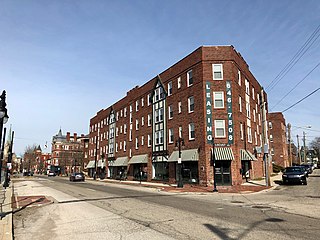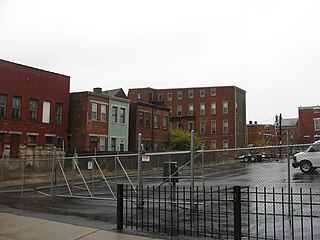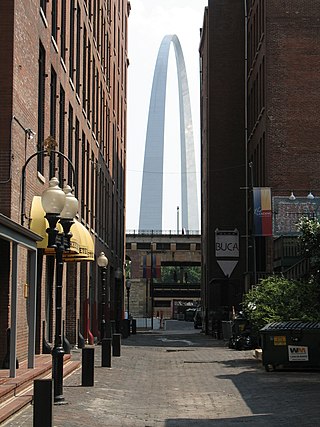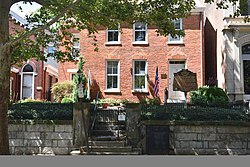
Clifton is one of the 52 neighborhoods of Cincinnati, Ohio. The population was 8,408 in the 2020 census.

Dumbarton House is a Federal style house located in the Georgetown neighborhood of Washington, D.C. It was completed around 1800. Its first occupant was Joseph Nourse, the first Register of the Treasury. Dumbarton House, a federal period historic house museum, stands on approximately an acre of gardens on the northern edge of Georgetown, District of Columbia. The house is listed on the National Register of Historic Places. Displaying a fine collection of period decorative arts, it gives the visitor a concrete sense of a substantial private residence in the early 1800s. Constructed in 1798–99, the house was a private residence until The National Society of The Colonial Dames of America (NSCDA) purchased it for its headquarters in 1928 and gave it the name it has today. In addition to meeting its administrative needs, the NSCDA wanted to illustrate domestic life in Georgetown in the early federal period. To achieve this, its two principal floors were opened to the public as a house museum in 1932, on the 200th anniversary of the birth of George Washington.

Union Square is a neighborhood located in the Sowebo area of Baltimore. It dates to the 1830s and includes a historic district of houses and commerce buildings.

Cincinnati, Ohio is home to numerous structures that are noteworthy due to their architectural characteristics or historic associations. The city also boasts Fountain Square and a riverfront that is being revitalized under The Banks project.

East Walnut Hills is one of the 52 neighborhoods of Cincinnati, Ohio. Established in 1867 and annexed in 1873, it is located in the eastern side of the city. The population was 4,103 at the 2020 census.
Wesley Chapel was a Methodist church in Cincinnati, Ohio, United States. Built in 1831 on the north side of Fifth Street between Broadway and Sycamore, it was a simple red brick Georgian structure copied after John Wesley's original Methodist church in London. With 1,200 seats, it was the largest meeting place west of the Alleghenies and the largest building in Cincinnati for many years. It was the seat of Methodism in Cincinnati.

The Kemper Log House is a two-story, double pen log house, which was built in 1804 by the Reverend James Kemper on Kemper Lane, in the Walnut Hills neighborhood. It was occupied by members of the Kemper family until 1897. It is one of the oldest houses built in Cincinnati, Ohio that is still standing. The house was moved in 1912 to the Cincinnati Zoo and then relocated at Heritage Village Museum in Sharon Woods. Its operation is coordinated with Historic Southwest Ohio, which maintains the village.

Police Station Five was a historic police station in the West End neighborhood of Cincinnati, Ohio. Constructed in the 1890s to serve both regular police and the city's patrol service, it was named a historic site in the late twentieth century, but historic designation was unable to save it from destruction.

The Henry Powell House is a historic house in the Mount Auburn neighborhood of Cincinnati, Ohio, United States. Constructed in the mid-19th century, it experienced a radical transformation near the end of the century under the direction of a leading regional architect. This French-style residence has been named a historic site.

Louisville, Kentucky is home to numerous structures that are noteworthy due to their architectural characteristics or historic associations, the most noteworthy being the Old Louisville neighborhood, the third largest historic preservation district in the United States. The city also boasts the postmodern Humana Building and an expanding Waterfront Park which has served to remove the former industrial appearance of the riverfront.
New St. Joseph Cemetery is a Catholic cemetery located at West Eighth Street and Nebraska Avenue in Cincinnati, Ohio in the Price Hill neighborhood. The original Old St. Joseph's Cemetery was founded at West Eight Street & Enright Avenue, in 1843 by Rev. John Baptist Purcell, for English speaking Catholics. The new cemetery was created in 1853 following the cholera outbreak which began in 1849, as the Irish section of St. Joseph Cemetery had reached its capacity, the new cemetery was located two miles (3 km) west. The Old St. Joseph's Cemetery, was used mostly by German Catholics.

Queensgate is one of the 52 neighborhoods of Cincinnati, Ohio. It sits in the valley of Downtown Cincinnati and is dominated by industrial and commercial warehouses. Cincinnati's nickname of "Porkopolis" started here with hog slaughtering in the early 19th century.

Mount Airy is one of the 52 neighborhoods of Cincinnati, Ohio. The neighborhood is home to Mount Airy Forest, one of the oldest urban reforestation projects in the country. The population was 9,210 at the 2020 census.

West End is one of the 52 neighborhoods of Cincinnati, Ohio. Originally a large residential neighborhood, the majority of the area was demolished in the mid-20th century for the construction of highway interchanges and an industrial park known as Queensgate. The population was 6,824 at the 2020 census.

Walnut Hills is one of the 52 neighborhoods of Cincinnati, Ohio. One of the city's oldest hilltop neighborhoods, it is a large diverse area on the near east side of Cincinnati. The population was 6,344 in the 2020 census.

The architecture of St. Louis exhibits a variety of commercial, residential, and monumental architecture. St. Louis, Missouri is known for the Gateway Arch, the tallest monument constructed in the United States. Architectural influences reflected in the area include French Colonial, German, early American, European influenced, French Second Empire, Victorian, and modern architectural styles.

The South End–Groesbeckville Historic District is located in part of the neighborhood of that name in Albany, New York, United States. It is a 26-block, 57-acre (23 ha) area south of the Mansion and Pastures neighborhoods with a mix of residential and commercial properties. In 1984 it was recognized as a historic district and listed on the National Register of Historic Places.
The Cincinnati riots of 1836 were caused by racial tensions at a time when African Americans, some of whom had escaped from slavery in the Southern United States, were competing with whites for jobs. The racial riots occurred in Cincinnati, Ohio, United States in April and July 1836 by a mob of whites against black residents. These were part of a pattern of violence at that time. A severe riot had occurred in 1829, led by ethnic Irish, and another riot against blacks broke out in 1841. After the Cincinnati riots of 1829, in which many African Americans lost their homes and property, a growing number of whites, such as the "Lane rebels" who withdrew from the Cincinnati Lane Seminary en masse in 1834 over the issue of abolition, became sympathetic to their plight. The anti-abolitionist rioters of 1836, worried about their jobs if they had to compete with more blacks, attacked both the blacks and white supporters.

The Betts–Longworth Historic District is located just northwest of downtown Cincinnati, Ohio. The district consists of a ten-block sub-neighborhood of the historic West End of Cincinnati that contains Federal, Italianate and Queen Anne styles. The Betts House located at 416 Clark Street was built in 1804 and is the oldest brick house in Ohio. The Old Jewish Cemetery, Cincinnati is also located in the district.




















